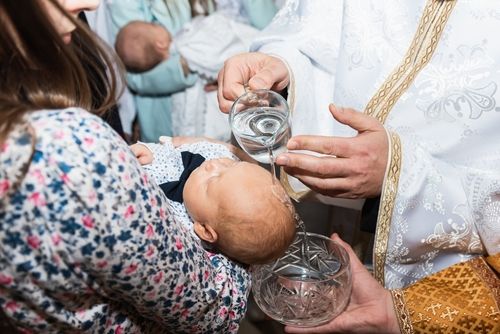 In the Christian world, the debate rages about the validity of various methods of baptism practiced by different denominations. Some sprinkle the baby with water. Others pour water over the baby’s head. A few immerse the baby in water, up to three times, to legitimize the baptism.
In the Christian world, the debate rages about the validity of various methods of baptism practiced by different denominations. Some sprinkle the baby with water. Others pour water over the baby’s head. A few immerse the baby in water, up to three times, to legitimize the baptism.
Baptism and christening customs in different regions vary widely from culture to culture. Here are some examples of the traditions that are practiced.
Australian Aboriginal Naming Ceremony
In Northeastern Australia, the Wik Mungkan tribe performs its naming ritual as the baby is being born. As labor and birth progress, the midwife recites the names of all living relatives of the child. The name she says when the placenta is delivered is the name given to the child.
Shortly after the birth, a ritual occurs during which the child’s mother and grandmother burn special leaves to create a purifying smoke. The baby is held near the smoke to protect its health throughout its life.
Chinese Infant and Child Traditions
It’s unlucky in China to name a child before it’s born. Often, the child will be given a meaningless name so that evil spirits will ignore it. Later, on an auspicious occasion, the child will be given its formal name.
Even though the baby’s name is chosen shortly after birth, the naming of the child isn’t celebrated until 100 days later, to mark the occasion of the baby surviving the first three months of life.
Every generation of Chinese children will be given the same middle name. There are 24 generational middle names, so it takes a while to get through them all.
Hindu Baptismal Customs
While a Hindu mother is pregnant, she reads verses from the Veda, the Hindu holy text, to provide a positive environment for her unborn child. Prayers are recited at the temple to bring the child health and happiness.
When the child is born, the exact time is noted, and a pandit, or Hindu priest, draws up the baby’s astrological chart. He also notes the best initials for the child to have, so the parents can use those initials for the infant’s name. Shortly after the child’s birth, the parents use honey to write the sacred word “Om” on the child’s tongue.
When the child is 40 days old, it is taken to the temple for namakarana — the naming ceremony. The pandit announces the child’s name and prays for its health, well-being, and long life. The baby is sprinkled with holy water, and a few drops of amrit, or sweetened water, are dropped on its tongue.
At six months, the annaprasana ceremony is held, and the baby has its first taste of cooked rice. When the child turns one year, its head is shaved, symbolizing that it is leaving behind any bad karma from its previous life and is starting this new life with a clean slate.
Shinto Baby Boys
In Japan, boys are given short, simple names at birth, which they’ll use throughout their childhood into their teen years. As they move toward adulthood, they’ll be given a longer, more formal name, which everyone who isn’t family uses.
When the baby boy is one month old, he is taken to a Shinto shrine, where the shinshoku (the priest) waves a tamagushi (a form of offering to the kami, or Shinto gods) over the child. This symbol shows that the child is pure and has a clean start in his life.
Baptism and christening customs around the world have one clear purpose: to welcome a new child into the community and bless it so it has a long, healthy, happy life. It doesn’t matter if water is sprinkled, poured, or used for immersion. What truly matters is that the child is joining a body of people who are committed to helping it grow into a decent, kind human being.